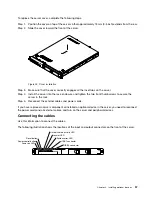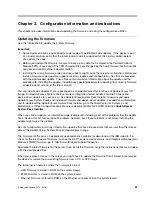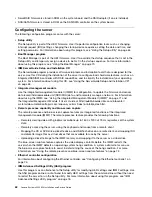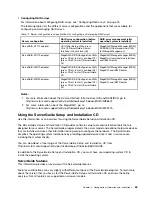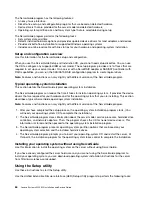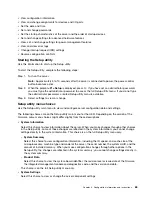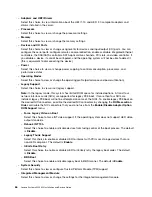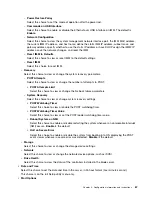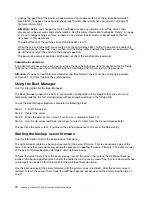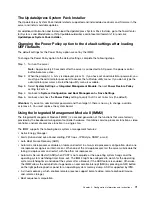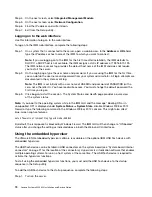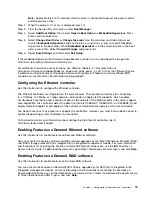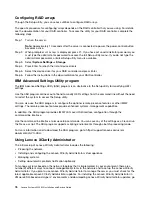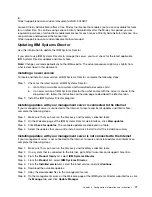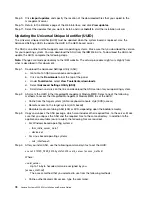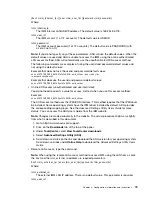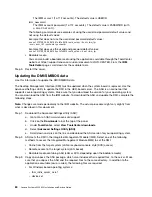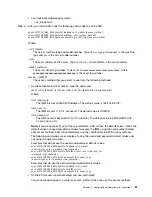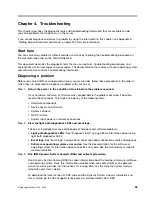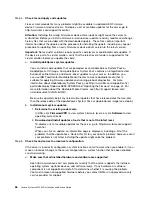
The Update
Xpress
System Pack Installer
The Update
Xpress
System Pack Installer detects supported and installed device drivers and firmware in the
server and installs available updates.
For additional information and to download the Update
Xpress
System Pack Installer, go to the ToolsCenter
for System x and BladeCenter at http://publib.boulder.ibm.com/infocenter/toolsctr/v1r0/ and click
UpdateXpress System Pack Installer
.
Changing the Power Policy option to the default settings after loading
UEFI defaults
The default settings for the Power Policy option are set by the IMM2.
To change the Power Policy option to the default settings, complete the following steps.
Step 1.
Turn on the server.
Note:
Approximately 20 seconds after the server is connected to AC power, the power-control
button becomes active.
Step 2.
When the prompt
<F1> Setup
is displayed, press
F1
. If you have set an administrator password, you
must type the administrator password to access the full Setup utility menu. If you do not type the
administrator password, a limited Setup utility menu is available.
Step 3.
Select
System Settings
➙
Integrated Management Module
, then set
Power Restore Policy
setting to
Restore
.
Step 4.
Go back to
System Configuration and Boot Management
➙
Save Settings
.
Step 5.
Go back and check the
Power Policy
setting to verify that it is set to
Restore
(the default).
Attention:
If you set an administrator password and then forget it, there is no way to change, override,
or remove it. You must replace the system board.
Using the Integrated Management Module II (IMM2)
The Integrated Management Module II (IMM2) is a second generation of the functions that were formerly
provided by the baseboard management controller hardware. It combines service processor functions, video
controller, and remote presence function in a single chip.
The IMM2 supports the following basic systems-management features:
• Active Energy Manager.
• Alerts (in-band and out-of-band alerting, PET traps - IPMI style, SNMP, e-mail).
• Auto Boot Failure Recovery (ABR).
• Automatic microprocessor disable on failure and restart in a two-microprocessor configuration when one
microprocessor signals an internal error. When one of the microprocessors fail, the server will disable the
failing microprocessor and restart with the other microprocessor.
• Automatic Server Restart (ASR) when POST is not complete or the operating system hangs and the
operating system watchdog timer times-out. The IMM2 might be configured to watch for the operating
system watchdog timer and reboot the system after a timeout, if the ASR feature is enabled. Otherwise,
the IMM2 allows the administrator to generate a nonmaskable interrupt (NMI) by pressing an NMI button
on the light path diagnostics panel for an operating-system memory dump. ASR is supported by IPMI.
• A virtual media key, which enables remote presence support (remote video, remote keyboard/mouse,
and remote storage).
• Boot sequence manipulation.
Configuration information and instructions
71
Summary of Contents for System x3250 M4
Page 1: ...Lenovo System x3250 M4 Installation and Service Guide Machine Type 2583 ...
Page 6: ...iv Lenovo System x3250 M4 Installation and Service Guide ...
Page 74: ...60 Lenovo System x3250 M4 Installation and Service Guide ...
Page 98: ...84 Lenovo System x3250 M4 Installation and Service Guide ...
Page 136: ...122 Lenovo System x3250 M4 Installation and Service Guide ...
Page 144: ...130 Lenovo System x3250 M4 Installation and Service Guide ...
Page 418: ...404 Lenovo System x3250 M4 Installation and Service Guide ...
Page 596: ...582 Lenovo System x3250 M4 Installation and Service Guide ...
Page 604: ...Taiwan BSMI RoHS declaration 590 Lenovo System x3250 M4 Installation and Service Guide ...
Page 612: ...598 Lenovo System x3250 M4 Installation and Service Guide ...
Page 613: ......
Page 614: ......

